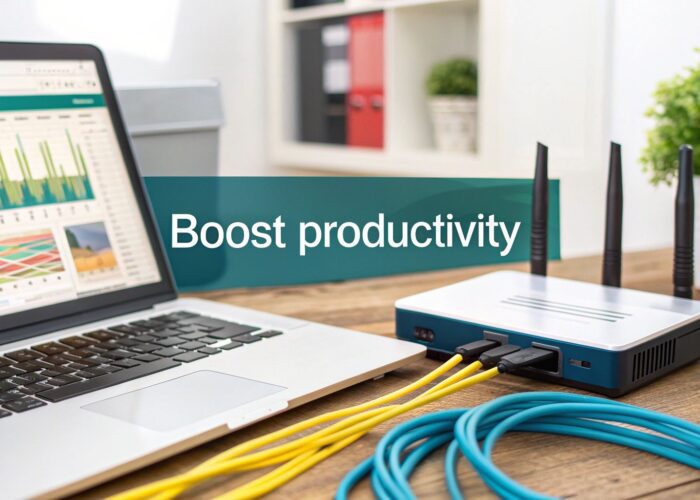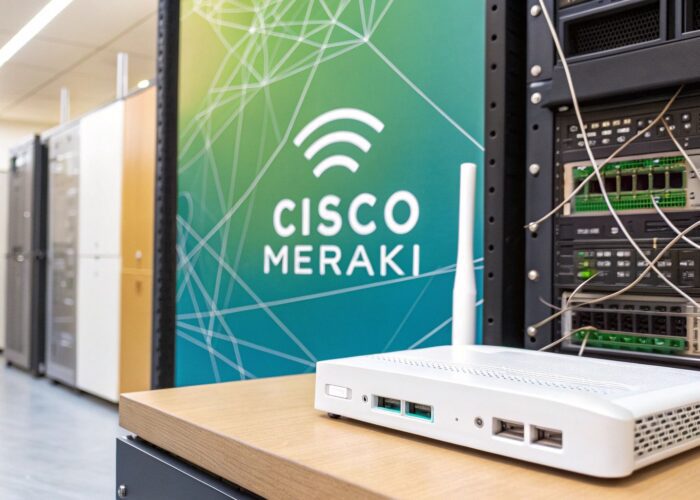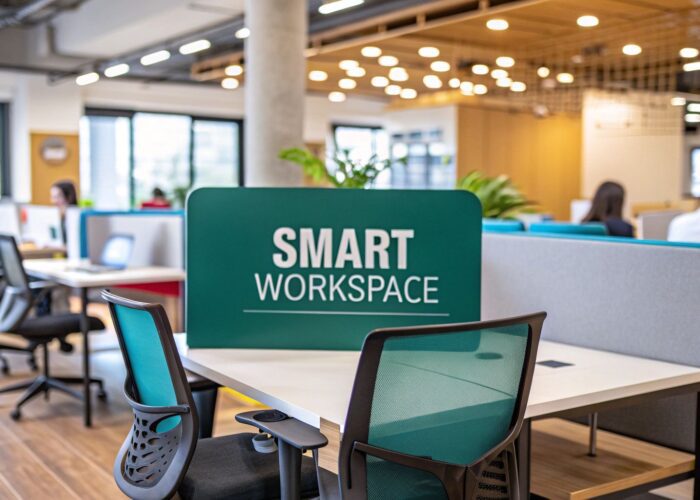Ever had a barista remember your regular coffee order? That little moment of recognition is the heart of customer experience personalization. It’s all about shifting away from generic, one-size-fits-all messaging and creating interactions that make people feel seen and valued. Let's chat about how your Wi-Fi network, especially one powered by Cisco Meraki, can become your secret weapon for creating these amazing moments.
What Is Customer Experience Personalization?
Think about the last time a brand genuinely wowed you. My guess is that the experience felt like it was designed just for you. That’s customer experience personalization in action. It's the craft of using what you know about your customers to shape their entire journey, making every step more helpful, intuitive, and memorable. We're talking about more than just slotting a first name into an email template; it's about anticipating what someone needs before they even ask.
This isn’t just a passing fad—it’s a fundamental change in how businesses operate. When customers feel understood, they’re far more likely to stick around and spend. Companies that nail personalization see a real impact, with studies showing a potential 40% increase in revenue compared to those that don't. It's simple, really: a great, personal experience builds loyalty.
Why It Matters Across Different Sectors
Personalization isn’t just for online retailers. Its power is felt everywhere, from the aisles of a busy shop to the lecture halls of a university and the meeting rooms of a modern office. Every industry uses it to solve unique problems and forge stronger relationships.
- Retail: Imagine a shopper getting a special offer on their favorite brand just as they walk into the store. That’s personalization turning a routine shopping trip into a curated experience.
- Education: For a university, it could mean sending targeted event notifications to students in a specific dorm or giving faculty seamless, secure access to the network resources they need.
- BYOD Corporate: In a corporate setting with a Bring-Your-Own-Device (BYOD) policy, it’s about giving employees and guests a secure, frictionless network connection that just works.
The Wi-Fi Connection
So, where do you begin creating these kinds of personal moments? A surprisingly powerful—and often overlooked—tool is your guest Wi-Fi network. The second a user connects, you have a golden opportunity to start a personalized conversation, especially when your network is built on robust hardware from leaders like Cisco and Meraki.
By turning the simple act of logging into Wi-Fi into a strategic touchpoint, you can transform a basic utility into a powerful engine for engagement.
This is where tools like Captive Portals and Authentication Solutions like IPSK and EasyPSK come into play. They turn a simple Wi-Fi connection into the first step of a tailored journey. Think of it as the perfect digital welcome mat, allowing you to deliver relevant content and create a secure, seamless experience right from the get-go.
You can explore strategies and examples for improving customer experience personalization to see how this works in the real world.
Turning Your Wi-Fi into a Personalization Powerhouse

Think of your guest Wi-Fi as more than just a free internet connection. It’s a goldmine for creating truly personal customer experiences. When someone logs into your network, it's not just a technical event; it’s the beginning of a digital conversation. This is your first, best chance to make a fantastic impression.
Your Wi-Fi network is essentially your digital welcoming committee. This is where top-tier hardware from providers like Cisco and Meraki lays the groundwork for something special. These robust networks do more than just provide a stable signal—they give you the platform to craft unique user journeys from the very first click.
The Captive Portal: More Than Just a Login Screen
So, how do you tap into this potential? The key is the Captive Portal—that login page everyone sees when they first connect. Forget the bland, generic pages that just ask for an email. Your captive portal should be a dynamic, intelligent welcome mat. A thoughtfully designed portal on a Meraki network becomes one of your most effective brand ambassadors.
This is your opportunity to gather valuable, consent-based information and deliver targeted content on the spot. It’s a fair trade: in exchange for reliable Wi-Fi, visitors share a few details that help you improve their experience. This simple shift turns a utility into a powerful tool for building real relationships.
For instance, a first-time visitor could be greeted with a welcome video and a special discount. A loyal customer, on the other hand, might see a personalized message and a reminder about their rewards points. This transforms a routine login into a genuinely engaging moment.
Your Wi-Fi network is the first digital handshake with your customer. A captive portal ensures that the first impression is not only positive but also personal and relevant to their needs.
This strategy works wonders in almost any environment because context is everything. A student's needs on a university campus are worlds away from a shopper's in a mall or an executive's visiting a corporate office.
Tailoring the Experience to the Environment
Personalizing the Wi-Fi connection means you can deliver the right message to the right person at precisely the right time.
-
Education: A university can configure its Meraki network to show campus event schedules, library hours, or even emergency alerts on the login screen. A student connecting in the science building might see an ad for an upcoming tech seminar, while someone in the arts quad gets an alert about a new gallery opening.
-
Retail: In a shopping center, the Captive Portal becomes a real-time marketing channel. Someone connecting near the food court could get a digital coupon for a smoothie, while a visitor in a department store receives an alert about a flash sale happening on their floor.
-
BYOD Corporate: The Wi-Fi experience is critical in a corporate setting, especially with so many people using their own devices (BYOD). Authentication Solutions like IPSK (Identity Pre-Shared Key) and EasyPSK make this seamless. A guest could get secure, temporary access with limited permissions, while an employee is instantly connected with full network privileges—all through a smooth and personalized login.
By pairing the rock-solid reliability of Cisco Meraki hardware with smart Authentication Solutions, you can flip a cost center (providing free Wi-Fi) into a powerful engine for engagement. You’re no longer just offering internet access; you're creating a smarter, more responsive environment that builds loyalty and drives real results.
Using Captive Portals for Memorable Wi-Fi Experiences
That first moment a person connects to your Wi-Fi network is a make-or-break opportunity. Think of it as a digital handshake. A generic, clunky login screen is like a limp, forgettable handshake. But a dynamic, personalized splash page? That's a warm, confident greeting that sets a positive tone for their entire visit.
This is exactly what a well-designed Captive Portal can do.
When your Wi-Fi is powered by a solid network like Cisco Meraki, that captive portal becomes so much more than a simple gateway to the internet. It’s your first and best chance to personalize the customer experience, making people feel seen and valued from the second they connect. This isn't just about being polite; it's smart business.
Crafting The Perfect First Impression
Imagine a regular shopper returning to your store and connecting to the Wi-Fi. Instead of a bland login box, she sees a welcome message with her name and a special offer on an item she’s looked at before. Or picture a university student in the library who connects and immediately gets a notification about extended study hours for finals week.
This isn't futuristic stuff; it's entirely possible with modern Authentication Solutions. By integrating a platform like Splash Access with your Meraki network, you can completely customize the login experience. The branding, messaging, and offers can all change based on who is connecting, what device they’re on, or even where they are on your property. You can turn a mundane login process into a genuinely helpful interaction.
The business case for this is crystal clear. Just look at the uplift companies see when they invest in this kind of personalization.
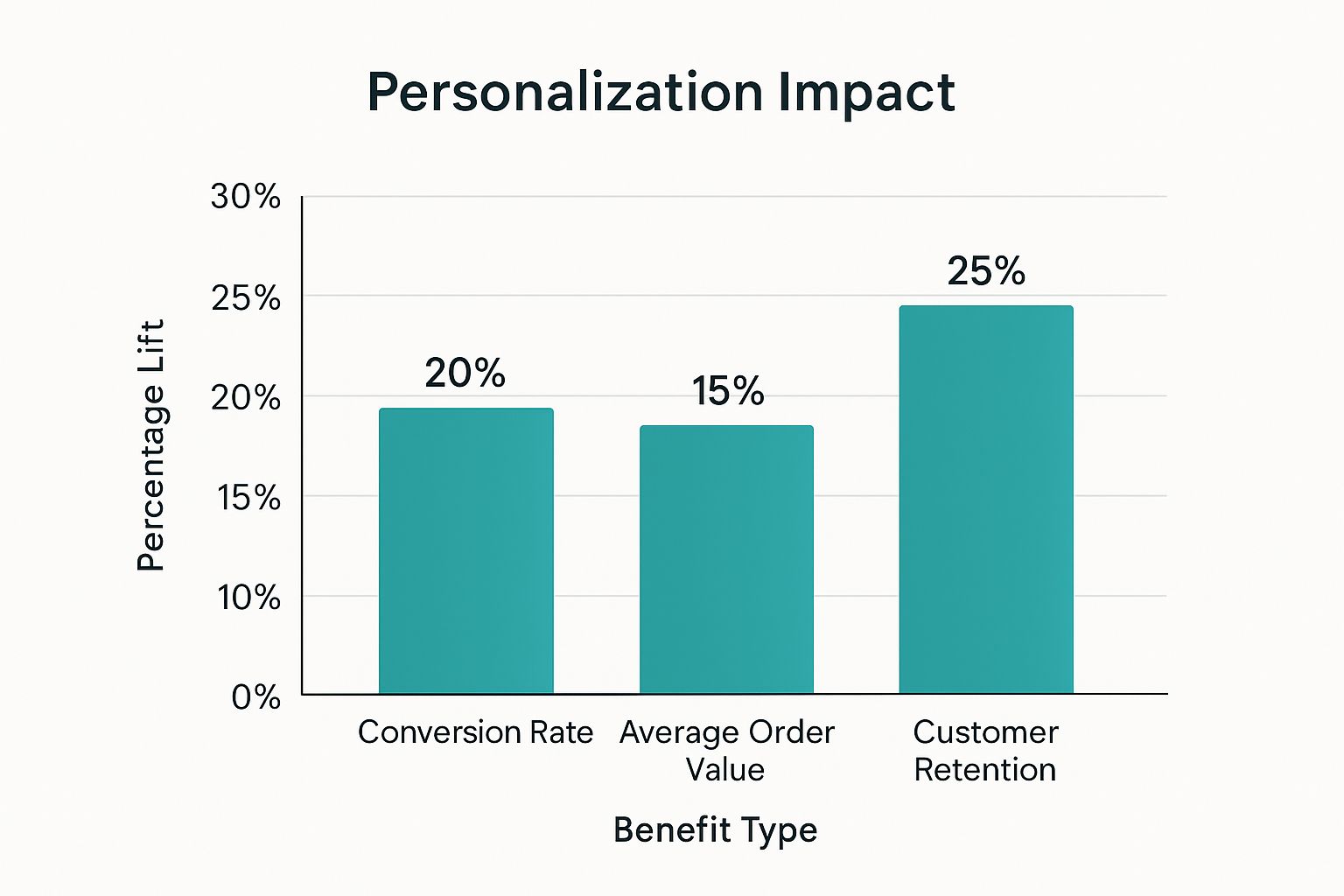
As the data shows, focusing on personalized experiences directly moves the needle on key metrics, with customer retention seeing the biggest jump. It really pays to make people feel welcome.
Personalization Opportunities by Sector via Captive Portal
The real power of using a Captive Portal for personalization lies in its flexibility. A smart approach can be adapted to fit just about any environment, from a bustling Retail hub to a quiet corporate office.
Here’s a quick look at how different sectors can put this into practice.
| Sector | Personalization Tactic | Desired Outcome |
|---|---|---|
| Retail | Display a coupon for a previously viewed item upon login for returning customers. | Increase in-store sales and customer loyalty. |
| Education | Show students relevant campus news, while visitors see a campus map and guest info. | Improve communication and streamline visitor navigation. |
| BYOD Corporate | Automatically connect employees via EasyPSK while directing visitors to a branded guest login. | Simplify IT management and maintain network security. |
As you can see, the goal is always to provide value that's relevant to the specific user in that specific moment. People expect and appreciate this level of tailored interaction.
This is the gap where a smart Wi-Fi portal can make a massive difference. To get a better handle on the technology, our guide on what a captive portal is and how it works is a great place to start.
Ultimately, a personalized Wi-Fi experience, especially one secured with advanced methods like IPSK, does more than just get people online. It shows them you've put thought into their needs. That's how you build trust, earn loyalty, and turn a simple utility into a memorable part of their journey with your brand.
Balancing Personalization with Seamless Security
A truly great personalized experience goes beyond just a flashy welcome message on a splash page. It's about making the entire process, right down to security, feel completely effortless. Your customers and employees want to get online without jumping through a bunch of hoops, but your organization needs to know the network is locked down tight. Striking that perfect balance between a friendly welcome and robust protection is what genuine customer experience personalization is all about.
The good news? You don't have to sacrifice user experience for a secure network. Modern Authentication Solutions are built to handle both. By ditching outdated, single-password setups, you can design a connection process that’s not only safer but feels tailored to each person walking through your door.
This is a game-changer in places like corporate offices, retail stores, and university campuses, where you have all sorts of people needing different levels of access. A one-size-fits-all security model just doesn't cut it anymore.
Moving Beyond the Single Password Problem
For a long time, the go-to for Wi-Fi security was a single pre-shared key (PSK) handed out to everyone. Simple, yes. Secure? Not even close. If one person leaves the company or a device gets compromised, you’re supposed to change the password for everyone and everything. It’s a massive headache that, let's be honest, often gets pushed aside, leaving your network wide open.
This is where more advanced Authentication Solutions step in. Technologies like Identity Pre-Shared Key (IPSK) and EasyPSK completely flip the script. Instead of one password for the masses, these systems let you generate a unique, private key for every single user or device.
Think of it like this: instead of a single master key for the entire building, you're giving each person their own personal key. If someone loses their key or no longer needs access, you just deactivate that one key. Everyone else goes about their day, completely unaffected.
This approach, especially when paired with powerful networks from providers like Cisco Meraki, creates the foundation for truly secure, personalized access. You can fine-tune network permissions for each user, making sure they get exactly the access they need—no more, no less.
Personalizing Security in Different Sectors
Once you can create unique credentials for everyone, you open up a whole new world of possibilities for tailoring the Wi-Fi experience. The security itself becomes part of the personalization.
- Education Campuses: A university can use IPSK to issue unique keys to students, faculty, and guests. A student's key might provide access to the general campus network and library resources, while a professor’s key could unlock access to secure academic servers. This tiered system keeps everyone connected smoothly while protecting sensitive data.
- Retail Environments: In a store, staff can get unique EasyPSK keys for their work devices, giving them secure access to inventory systems and registers. Shoppers, on the other hand, connect through a branded Captive Portal, creating a completely separate—and equally secure—guest experience.
- BYOD Corporate Offices: "Bring Your Own Device" policies are everywhere, but they can be a security nightmare. With EasyPSK, an employee can easily register their personal smartphone or laptop to receive a unique security key that grants them access to company resources. A visitor coming in for a meeting? They can get a temporary key that automatically expires when they leave.
This method of assigning individual credentials doesn't just boost security; it also makes life a whole lot easier for IT teams. If you want to get into the nitty-gritty of how this works, you can learn more about using security keys for Wi-Fi and how to deploy them effectively. By personalizing security, you’re building trust, showing users that their connection isn't just convenient, but also completely safe.
Real-World Wi-Fi Personalization in Action
Theory is great, but seeing how this all works in the real world is where things get interesting. Let's look at how actual businesses in Retail, Education, and even corporate offices are using their Wi-Fi networks to get tangible results. These stories show how a smart strategy can turn a simple connection into a powerful interaction.
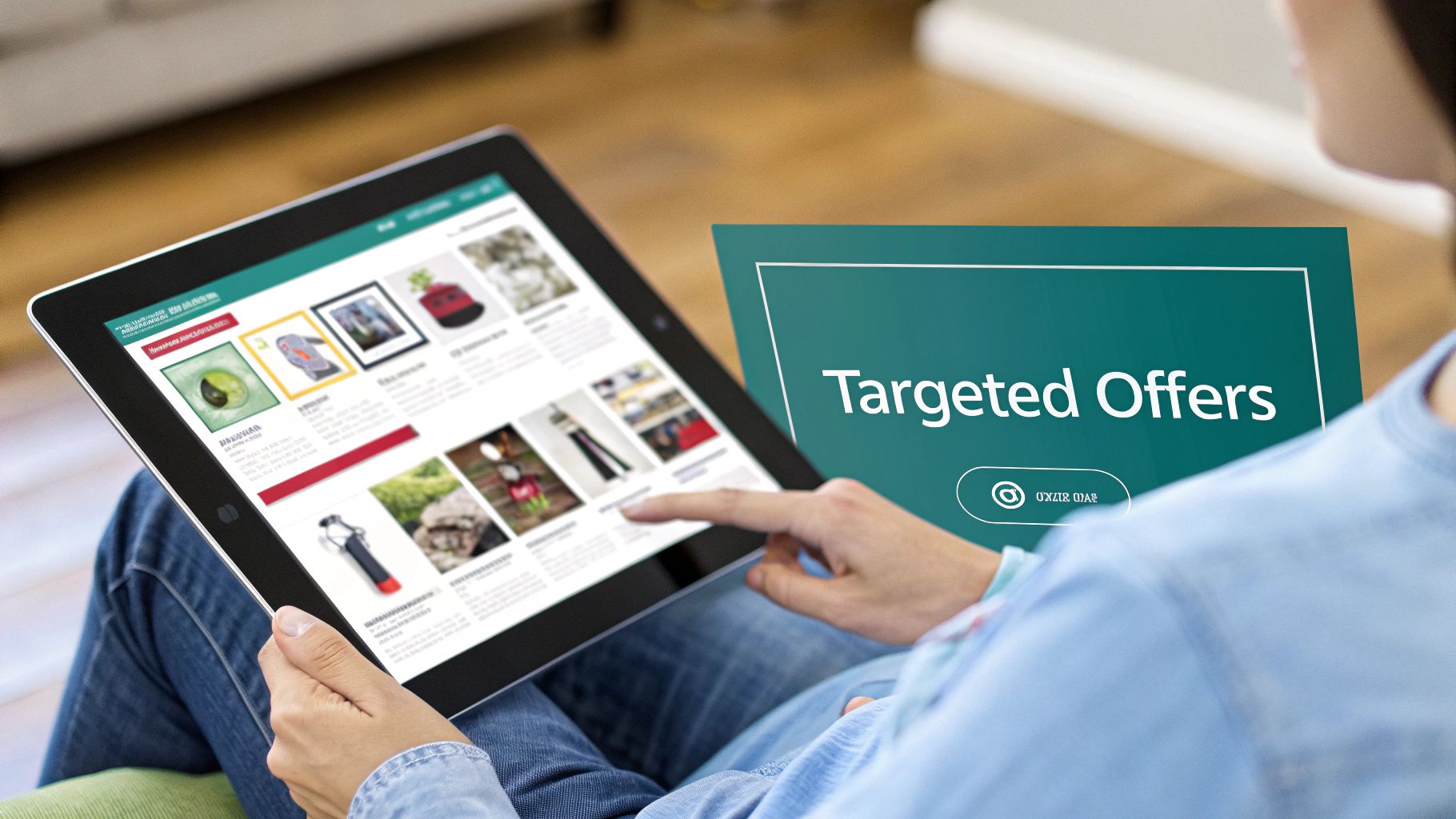
These examples aren't just about flashy tech. They’re about solving everyday problems and building stronger relationships. Whether it’s driving more sales, making campus life easier, or securing a modern workplace, the right approach to Wi-Fi can make a massive difference.
Driving Retail Sales with Location-Aware Offers
Imagine a big retail chain with dozens of stores. They already had a solid Cisco Meraki network, but they wanted to do more than just give out free Wi-Fi. Their goal was to turn that network into a tool that directly boosted in-store sales.
They did this by setting up a smart Captive Portal that could recognize returning customers. When a known shopper connected to the Wi-Fi, the system would check their location in the store and look at their past purchases. So, if a customer was lingering in the electronics department, a personalized notification would pop up on their phone offering 15% off a new pair of headphones.
This wasn't just another generic ad. It was a perfectly timed, relevant offer delivered at the exact moment the customer was thinking about buying.
The results were impressive. The chain saw a real jump in sales for promoted items and a noticeable increase in customer loyalty. Shoppers felt like the brand actually understood them, which is a powerful way to build a lasting connection. We have a whole guide on other practical ways to https://splashaccess.com/how-to-improve-customer-experience/.
Streamlining Campus Life in Education
A bustling university campus had a completely different challenge. Thousands of students, faculty, and visitors were connecting to their network every day. They needed a way to communicate with everyone effectively while providing a seamless, secure experience for each group.
Their solution was to completely rethink their Wi-Fi Captive Portal to serve different content based on who was logging in.
- For Students: When they connected, they saw a dashboard with campus event reminders, dining hall specials, and important academic deadlines.
- For Faculty: Professors got immediate access to secure academic resources without jumping through extra hoops.
- For Visitors: Guests were greeted with a beautifully branded page featuring a campus map, visitor info, and a super simple login.
This tiered approach, all managed through their Meraki dashboard, turned the network into much more than an internet utility. It became a central communication hub that genuinely improved campus life. Event check-ins went smoother, and important announcements always hit the right audience.
Simplifying BYOD in the Corporate World
Over in the corporate sector, a fast-growing tech company was struggling with its "Bring Your Own Device" (BYOD) policy. Managing guest access was a constant headache for the IT team, and employees found it clunky to connect their personal devices securely.
They implemented an Authentication Solution using EasyPSK. This allowed the IT department to generate unique, secure Wi-Fi keys for every single employee and their devices. Guests, on the other hand, could get temporary keys that automatically expired after their visit.
This one change completely transformed their network management. The process became automated and far more secure. Employee satisfaction shot up because they could connect their personal laptops and phones without any fuss, and the IT team was finally freed from the endless cycle of resetting a single, shared password. It’s a great example of how customer experience personalization applies to your internal teams, too.
This focus on individualized experiences is paying off for businesses everywhere. This point is well-illustrated in this customer experience case study.
Your Next Steps to a Personalized Wi-Fi Experience

Ready to turn your Wi-Fi from a simple utility into a powerful tool for connection? The path to genuine customer experience personalization starts with a solid plan. It's about seeing your network not just as an internet connection, but as a digital front door.
The whole idea is to make every login a meaningful touchpoint. It doesn’t matter if you’re connecting a student in an Education setting, a shopper in Retail, or a guest in a BYOD Corporate environment—with the right strategy, you can create an experience that feels personal and valuable.
Building Your Personalization Roadmap
Jumping into personalization doesn't have to be overwhelming. The trick is to focus on making the experience secure, smooth, and genuinely useful from the moment someone connects. This means pairing solid hardware with intelligent software.
Here’s a practical, step-by-step roadmap to get you started:
-
Assess Your Foundation: It all begins with a reliable network, and that’s where Cisco Meraki hardware comes in. A strong backbone is essential to handle the data and traffic that personalization demands, all without sacrificing speed or stability.
-
Design Your Welcome Mat: Your Captive Portal is your digital handshake. Customize your splash page to match your brand and offer something valuable right away. For a detailed walkthrough, take a look at our guide on how to set up guest Wi-Fi.
-
Implement Smart Security: Ditch the one-size-fits-all password. Modern Authentication Solutions like IPSK and EasyPSK give each user and device unique, secure credentials. This is a game-changer for Education, Retail, and corporate settings where security is paramount.
When you focus on these core steps, you’re no longer just handing out Wi-Fi access. You're actively crafting a better, more engaging experience that builds loyalty.
By following this plan, you're on your way to building a network that doesn't just connect people—it understands them. And that’s how you deliver personalized moments that truly matter.
Frequently Asked Questions
Jumping into Wi-Fi personalization often brings up a few questions. Let's walk through some of the common ones to clear things up and show you how tools from Cisco Meraki can help you build better experiences for everyone who connects.
How Does a Captive Portal Actually Personalize an Experience?
Think of a Captive Portal as more than just a login screen—it’s your first handshake with a visitor. This is where personalization really begins. When someone connects to your Meraki Wi-Fi, the portal knows if they're a first-timer or a regular.
This simple bit of information changes everything. In a Retail store, a new guest could get a welcome video and a 10% off coupon to get them started. A loyal customer, on the other hand, might be greeted by name and see offers based on things they've bought before. In an Education setting like a university, students could see the latest campus news, while visitors get a helpful map. It's all about making that first interaction immediately relevant.
Is It Complicated to Set Up Different Access Levels with IPSK?
Honestly, it's surprisingly simple. Authentication Solutions like Identity Pre-Shared Key (IPSK) and EasyPSK were built to make secure, multi-level access easy, not to give your IT team a headache. Instead of one password for the entire network (which is a security nightmare), you can create unique keys for every single person or device.
Imagine a BYOD corporate office. An employee's personal laptop can get a key with full network privileges, while a guest's phone gets a key that only grants limited internet access and expires in 24 hours. The best part? This whole process can be automated, making life easier for IT while giving every user a smooth, secure connection that just works.
What Data Can Be Ethically Used to Enhance Wi-Fi Connections?
Great question, and it's one we take seriously. The foundation of any good personalization strategy is trust. Any data you collect should be done with clear consent and used only to make the user's immediate experience better.
The goal is to use data to be helpful, not intrusive. This means focusing on contextual information that adds value right away.
So, what kind of data are we talking about? It's usually straightforward stuff like:
- User Type: Is this person a student, a guest, an employee, or a returning customer?
- Location on Site: Where are they in your store, campus, or building?
- Login History: Is this their first visit or their fiftieth?
This information lets you deliver relevant content—like a special offer in the electronics department of a Retail store or class schedule updates in a specific university building—without ever feeling invasive. It’s all about making their connection more useful.
Ready to turn your guest Wi-Fi from a simple utility into a powerful personalization engine? Splash Access works right alongside your Cisco Meraki network to create secure, engaging, and memorable connection experiences. Start your journey with us today.
